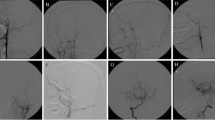Summary
Encephalo-duro-arterio-synangiosis (EDAS) was done in 16 Japanese children with Moyamoya disease on 22 sides. The results were evaluated clinically, angiographically, and by positron emission computed tomography (PET). Postoperative external carotid angiograms showed a good collateral circulation through EDAS in 72 percent of the treated sides. Two-thirds of the sides examined by PET showed improvement in cerebral blood circulation, particularly at the surgically-treated cortex. Postoperatively the symptoms disappeared in those with good new collateral formation. TIA, RIND, and/or involuntary movement disappaered in 31 percent and partially so in 44 percent 6 months after EDAS. The TIA in the lower limb and/ or involuntary movement persisted in some children. This surgical approach seems applicable particularly for children with the ischaemic type of Moyamoya disease, however, the procedure also has drawbacks. Development of collateral circulation was insufficient in some cases, and the territories of the anterior cerebral artery (ACA) or posterior cerebral artery (PCA) were often not covered, even in those with a good new collateral formation in the middle cerebral arterial (MCA) area.
Similar content being viewed by others
References
Balagura S, Farris WA (1985) Treatment of moyamoya disease by cerebroarteriosynangiosis. Surg Neurol 23: 270–274
The EC/IC Bypass Study Group (1985) The international co-operative study of extracranial/intracranial arterial anastomoses (EC/IC bypass study): methodology and entry characteristics. Stroke 16: 397–405
The EC/IC Bypass Study Group (1985) Failure of extracraniali-ntracranial arterial bypass to reduce the risk of ischemic stroke: results of an international randomized trial. N Engl J Med 313: 1191–1200
Gibbs LM, Wise RJS, Leenders KLet al (1984) Evaluation of cerebral perfusion reserve in patients with carotid-artery occlusion. Lancet i: 310–314
Ishii R, Ichikawa A, Takeuchi S, Tanaka R (1986) Hemodynamic evaluation after surgical treatment for moyamoya disease. Jpn J Stroke 8: 200–207 (in Japanese)
Karasawa J (1978) Studies on the surgical treatment of moyamoya disease. J Nara Med Ass 29: 375–397 (in Japanese)
Karasawa J, Kikuchi H, Furuse S, Sakaki T, Yoshida Y, Ohnishi H, Taki W (1977) A surgical treatment of moyamoya disease. “Encephalo-myo-synangiosis”. Neurol Med Chir (Tokyo) 17: 29–37
Karasawa J, Kikuchi H, Furuse S, Kawamura J, Sakaki T (1978) Treatment of moyamoya disease with STA-MCA anastomosis. J Neurosurg 49: 679–688
Karasawa J, Kikuchi H, Kawamura J, Sakai T (1980) Intracranial transplantation of the omentum for cerebrovascular moyamoya disease: a two-year follow-up study. Surg Neurol 14: 444–449
Kikuchi H, Karasawa J, Nagata I (1986) Nation-wide investigation in occlusion of the circle of Willis. Report of 1985. In: Handa H (eds) Annual report of 1985 on the cooperative study of occlusion of the circle of Willis to the Ministry of Health and Welfare 19–25 (in Japanese)
Kobayashi K, Takeuchi S, Tsuchida T, Ito J (1981) Encephalo-myo-synangiosis (EMS) to moyamoya disease-with special reference to postoperative angiography. Neurol Med Chir (Tokyo) 21: 1229–1238 (in Japanese)
Krayenbühl HA (1975) The moyamoya syndrome and the neurosurgeon. Surg Neurol 4: 353–360
Kurokawa T, Tomita S, Ueda K, Narazaki O, Hanai T, Hasuo K, Matsushima T, Kitamura K (1985) Prognosis of occlusive disease of the circle of Willis (Moyamoya disease) in children. Pediatr Neurol 1: 274–277
Kuwabara Y (1986) Evaluation of CBF, OEF, CMRO2 and mean transit time in moyamoya disease using positron emission computed tomography. Jpn J Nucl Med 23: 1381–1402 (in Japanese)
Matsushima T, Fujiwara S, Nagata S, Fujii K, Fukui M, Kitamura K, Hasuo K (1989) Surgical treatment for pediatric patients with Moyamoya Disease by indirect revascularization procedures (EDAS, EMS, EMAS). Acta Neurochir (Wien) 98: 135–140
Matsushima Y, Aoyagi M, Fukai N, Tanaka K, Tsuruoka S, Inaba Y (1982) Angiographic demonstration of cerebral revascularization after encephalo-duro-arterio-synangiosis performed on pediatric moyamoya patients. Bull Tokyo Med Dent Univ 29: 7–17
Matsushima Y, Fukai N, Tanaka K, Tsuruoka S, Aoyagi M, Inaba Y (1980) A new operative method for moyamoya disease: A presentation of a case who underwent encephalo-duro-arterio (STA) -synangiosis. Nervous System in Children 5: 249–255 (in Japanese)
Matsushima Y, Fukai N, Tanaka K, Tsuruoka S, Inaba Y, Aoyagi M, Ohno K (1981) A new surgical treatment of moyamoya disease in children: a preliminary report. Surg Neurol 15: 313–320
Matsushima Y, Inaba Y (1984) Moyamoya disease in children and its surgical treatment. Introduction of a new surgical procedure and its follow-up angiograms. Child's Brain 11: 155–170
Matsushima Y, Yamaguchi T, Takasato Y, Tomida S, Fukumoto T, Suzuki R, Tomita H, Inaba Y (1986) Changes in symptoms after encephalo-duro-arterio-synangiosis (EDAS) in pediatric moyamoya disease. No To Hattatsu 18: 3–7 (in Japanese)
Miyamoto S, Kikuchi H, Karasawa J, Nagata I, Yamazoe N, Akiyama Y (1988) Pitfalls in the surgical treatment of moyamoya disease. Operative techniques for refractory cases. J Neurosurg 68: 537–543
Nakagawa Y, Gotoh S, Shimoyama M, Ohtsuka K, Mabuchi S, Sawamura Y, Abe H, Tsuru M (1983) Reconstructive operation for moyamoya disease-Surgical indication for the hemorrhagic type and preferable operative methods. Neurol Med Chir (Tokyo) 23: 464–470 (in Japanese)
Nakagawa Y, Shimoyama M, Kashiwaba T, Suzuki Y, Gotoh S, Miyasaka K, Takei H, Gotoh S, Ohtsuka K, Abe H, Tsuru M (1981) Reconstructive operation of moyamoya disease and its problems. Neurol Surg 9: 305–314 (in Japanese)
Okuno T, Hatsutori H, Mikawa H, Yonekawa Y, Handa H (1984) Prognosis of “Moyamoya disease”. In: Handa H (ed) Annual report of 1983 on the cooperative study of occlusion of the circle of Willis to the Ministry of Health and Welfare, pp 46–55
Olds MV, Griebel RW, Hoffman HJ, Craven M, Chuang S, Schutz H (1987) The surgical treatment of childhood moyamoya disease. J Neurosurg 66: 675–680
Spetzler RF, Roski RA, Kopaniky DR (1980) Alternative superficial temporal artery to middle cerebral artery revascularization procedure. Neurosurgery 7: 484–485
Takeuchi S, Tsuchida T, Kobayashi K, Fukuda M, Ishii R, Tanaka R, Ito J (1983) Treatment of moyamoya disease by temporal muscle graft “Encephalo-myo-synangiosis”. Child's Brain 10: 1–15
Author information
Authors and Affiliations
Rights and permissions
About this article
Cite this article
Matsushima, T., Fukui, M., Kitamura, K. et al. Encephalo-duro-arterio-synangiosis in children with Moyamoya disease. Acta neurochir 104, 96–102 (1990). https://doi.org/10.1007/BF01842826
Issue Date:
DOI: https://doi.org/10.1007/BF01842826




